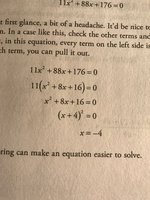Factoring algebraic expressions
- Thread starter aiwil123
- Start date
pka
Elite Member
- Joined
- Jan 29, 2005
- Messages
- 11,988
What you posted is far too vague for us to help.Can anyone explain it to me, please!?
Please give us something that tell us what help you need.
There is quite a lot on that attachment. So say what part(s) with which we can help you.
Otis
Elite Member
- Joined
- Apr 22, 2015
- Messages
- 4,592
Hello aiwil.
11·x2 +88·x +176 = 0
Each of those numbers is a multiple of 11.
11·1·x2 +11·8·x +11·16 = 0
In other words, 11 is a common factor in each term. That means we can "pull out" the common factor, and write it in front of what's left.
11(x2 +8x +16) = 0
The next step is to factor the quadratic polynomial (x2+8x+16).
When we try to factor a polynomial in the form Ax2+Bx+C, we firstr look for two numbers (I'll call them 'number1' and 'number2') whose product is C and whose sum is B. That is, we're hoping to find two numbers so that
number1 × number2 = 16
number1 + number2 = 8
The polynomial's factorization then takes the form
Ax2 + Bx + C = (x + number1)(x + number2)
With a little thought, we realize the two numbers are 4 and 4 because
4 × 4 = 16
4 + 4 = 8
Therefore, the quadratic polynomial factors as (x+4)(x+4), and we can write that as (x+4)2.
(x + 4)2 equals zero when x+4 is zero.
x + 4 = 0
Subtract 4 from each side.
x + 4 - 4 = 0 - 4
x = -4
Questions?
?
11·x2 +88·x +176 = 0
Each of those numbers is a multiple of 11.
11·1·x2 +11·8·x +11·16 = 0
In other words, 11 is a common factor in each term. That means we can "pull out" the common factor, and write it in front of what's left.
11(x2 +8x +16) = 0
The next step is to factor the quadratic polynomial (x2+8x+16).
When we try to factor a polynomial in the form Ax2+Bx+C, we firstr look for two numbers (I'll call them 'number1' and 'number2') whose product is C and whose sum is B. That is, we're hoping to find two numbers so that
number1 × number2 = 16
number1 + number2 = 8
The polynomial's factorization then takes the form
Ax2 + Bx + C = (x + number1)(x + number2)
With a little thought, we realize the two numbers are 4 and 4 because
4 × 4 = 16
4 + 4 = 8
Therefore, the quadratic polynomial factors as (x+4)(x+4), and we can write that as (x+4)2.
(x + 4)2 equals zero when x+4 is zero.
x + 4 = 0
Subtract 4 from each side.
x + 4 - 4 = 0 - 4
x = -4
Questions?
?
I would explain it a bit differently from otis, but fundamentally it is the same idea in a different order.
[MATH]11x^2 + 88x + 176 = 0 \implies \\ 11(x^2) + 8(11x) + 11(16) = 0 \implies \\ \dfrac{1}{11} * \{11(x^2) + 8(11x) + 11(16)\} = \dfrac{1}{11} * 0 \implies\\ x^2 + 8x + 16 = 0 \implies \\ x^2 + 2(4 * x) + 4^2 = 0 \implies \\ (x + 4)^2 = 0 \implies \\ x + 4 = \pm \sqrt{0} = 0 \implies \\ x = -4.[/MATH]
[MATH]11x^2 + 88x + 176 = 0 \implies \\ 11(x^2) + 8(11x) + 11(16) = 0 \implies \\ \dfrac{1}{11} * \{11(x^2) + 8(11x) + 11(16)\} = \dfrac{1}{11} * 0 \implies\\ x^2 + 8x + 16 = 0 \implies \\ x^2 + 2(4 * x) + 4^2 = 0 \implies \\ (x + 4)^2 = 0 \implies \\ x + 4 = \pm \sqrt{0} = 0 \implies \\ x = -4.[/MATH]
Hello aiwil.
11·x2 +88·x +176 = 0
Each of those numbers is a multiple of 11.
11·1·x2 +11·8·x +11·16 = 0
In other words, 11 is a common factor in each term. That means we can "pull out" the common factor, and write it in front of what's left.
11(x2 +8x +16) = 0
The next step is to factor the quadratic polynomial (x2+8x+16).
When we try to factor a polynomial in the form Ax2+Bx+C, we firstr look for two numbers (I'll call them 'number1' and 'number2') whose product is C and whose sum is B. That is, we're hoping to find two numbers so that
number1 × number2 = 16
number1 + number2 = 8
The polynomial's factorization then takes the form
Ax2 + Bx + C = (x + number1)(x + number2)
With a little thought, we realize the two numbers are 4 and 4 because
4 × 4 = 16
4 + 4 = 8
Therefore, the quadratic polynomial factors as (x+4)(x+4), and we can write that as (x+4)2.
(x + 4)2 equals zero when x+4 is zero.
x + 4 = 0
Subtract 4 from each side.
x + 4 - 4 = 0 - 4
x = -4
Questions?
?
No, I get it now! Thank you so much!
I would explain it a bit differently from otis, but fundamentally it is the same idea in a different order.
[MATH]11x^2 + 88x + 176 = 0 \implies \\ 11(x^2) + 8(11x) + 11(16) = 0 \implies \\ \dfrac{1}{11} * \{11(x^2) + 8(11x) + 11(16)\} = \dfrac{1}{11} * 0 \implies\\ x^2 + 8x + 16 = 0 \implies \\ x^2 + 2(4 * x) + 4^2 = 0 \implies \\ (x + 4)^2 = 0 \implies \\ x + 4 = \pm \sqrt{0} = 0 \implies \\ x = -4.[/MATH]
You help me too! Thank you!!

